Under the Covers of the Technics SL 10 Turntable….
by Nick Seiflow
The beautifully easy-to-operate Technics SL10 is anything but simple under the smooth lines of its aluminum skin.
What follows is not a manual for disassembly and maintenance, but more of a tribute to the Golden Age of turntable design.
Such a table as the SL-10 could never be made again. Sad, but based on the economies of scale whomsoever tried to build and market such a machine would quickly find themselves selling pencils on the street corner. To design this table from scratch alone would involve massive amounts of R&D. let alone actually making and marketing it.
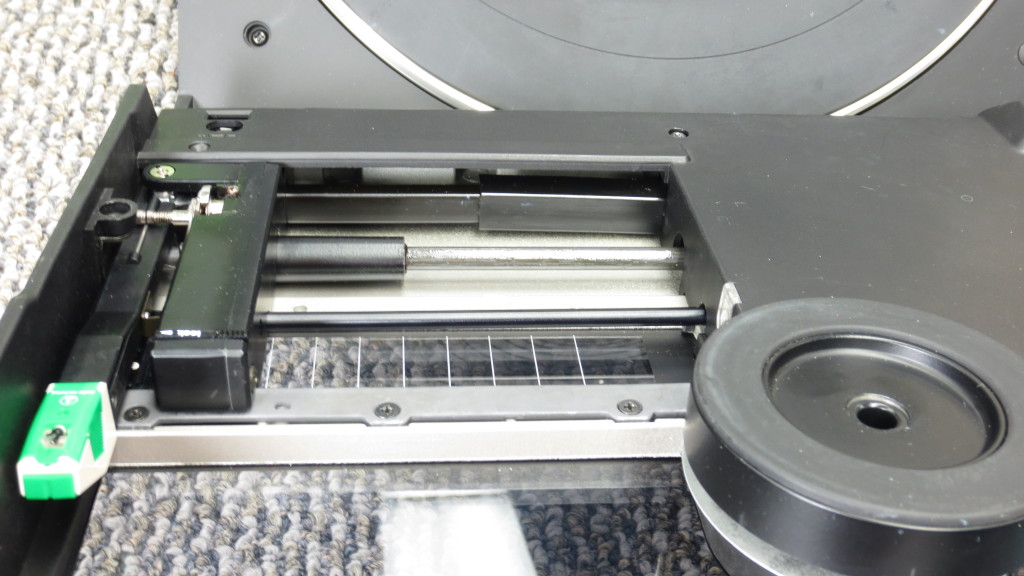
Technics SL 10 Turntable – A view of the arm assembly before the work begins… The problem – broken thread, no arm movement, no music. The dust looks worse than it really is…. many screws to remove, and some wiggling to remove the record clamp, and work can begin!
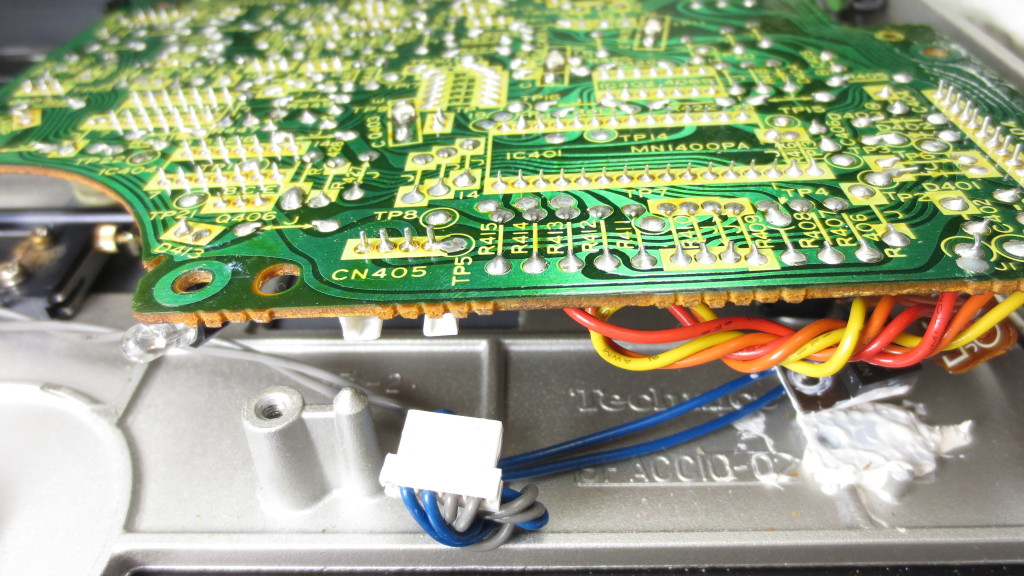
Technics SL 10 Turntable – And just when you think things will be easy, after wrestling with the record clamp there is a large circuit board to remove; this involves unscrewing a transistor and unlocking a wire loom or two… Really, it’s quite remarkable just how much circuitry and mechanical parts are under the simple exterior of the SL-10. Very full, but beautifully, logically arranged.
The photos give some idea of the electronic complexity, and it’s obvious that there is little or no spare space inside this tiny unit. Luckily, as with most electronic components (apart from capacitors) as long as the individual parts are conservatively specified then there will be little cause to worry about failure.
The one part that seems to require any attention is the thread drive for the travelling tangential arm. This is a mechanical feature and ultimately the thread itself may need replacing. Such was the case with the pictured example.
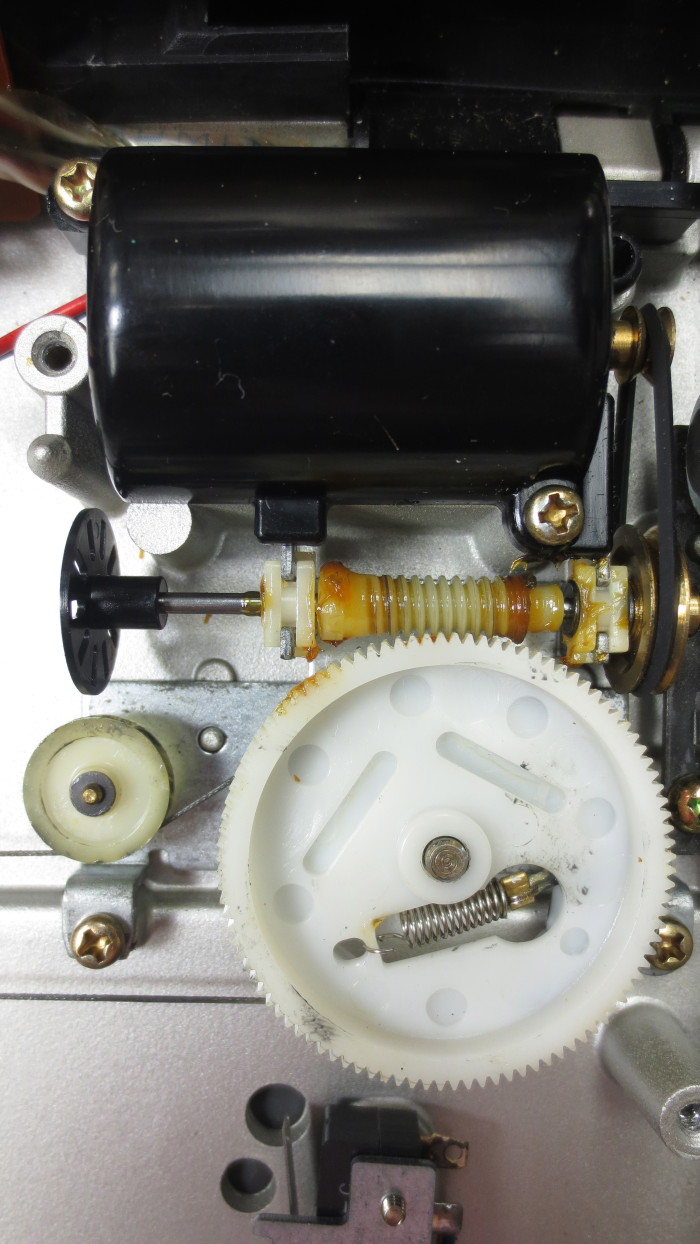
Technics SL 10 Turntable – An overview of the arm motor. The motor is the black cylinder at the top of the image; this actuates the worm-drive via a small flat belt. The thread drive (lower left) is kept in tension by the spring seen at the bottom of the large nylon gear.
The actual mechanism, once revealed (and this involves removing covers and accumulating an impressive pile of screws) is really rather simple, involving a small motor, a couple of gears, and of course the waxed thread that actually pulls the arm across the record.
Replacing the thread is not as hard as it seems: it’s a typically fiddly operation requiring some concentration and a willingness not to drink too much espresso – steady hands are a help! Once done, reassembly is a mirror image of disassembly, with no need to wield the soldering iron: a screwdriver or two is all that’s needed.
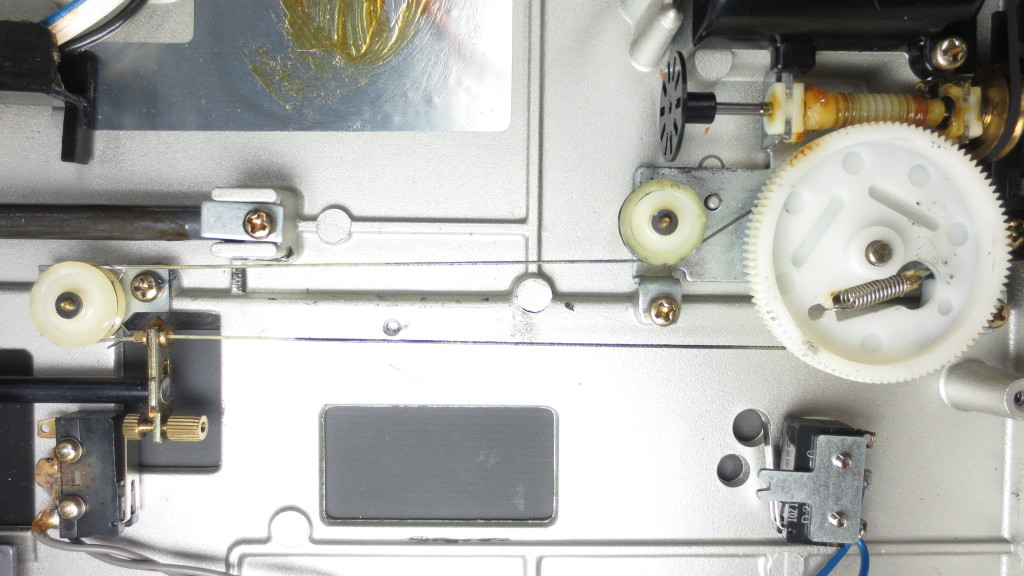
Technics SL 10 Turntable – This image shows the thread-drive in its entirety. The thread is greased throughout. Again, the whole thread is kept under tension by the spring in the main gear.
What strikes you in this process is again a sense of respect for the utterly well thought-out design. No space is wasted; components are uniformly of high quality, and everything comes together just perfectly to produce a really rather marvelous device. Even the platter itself (which didn’t have to be removed, but curiosity got the better of me…) is an impressive piece: drilled for balance, superbly machined, surprisingly heavy, and damped with anti-resonance material, it is a highly confidence-inspiring piece.
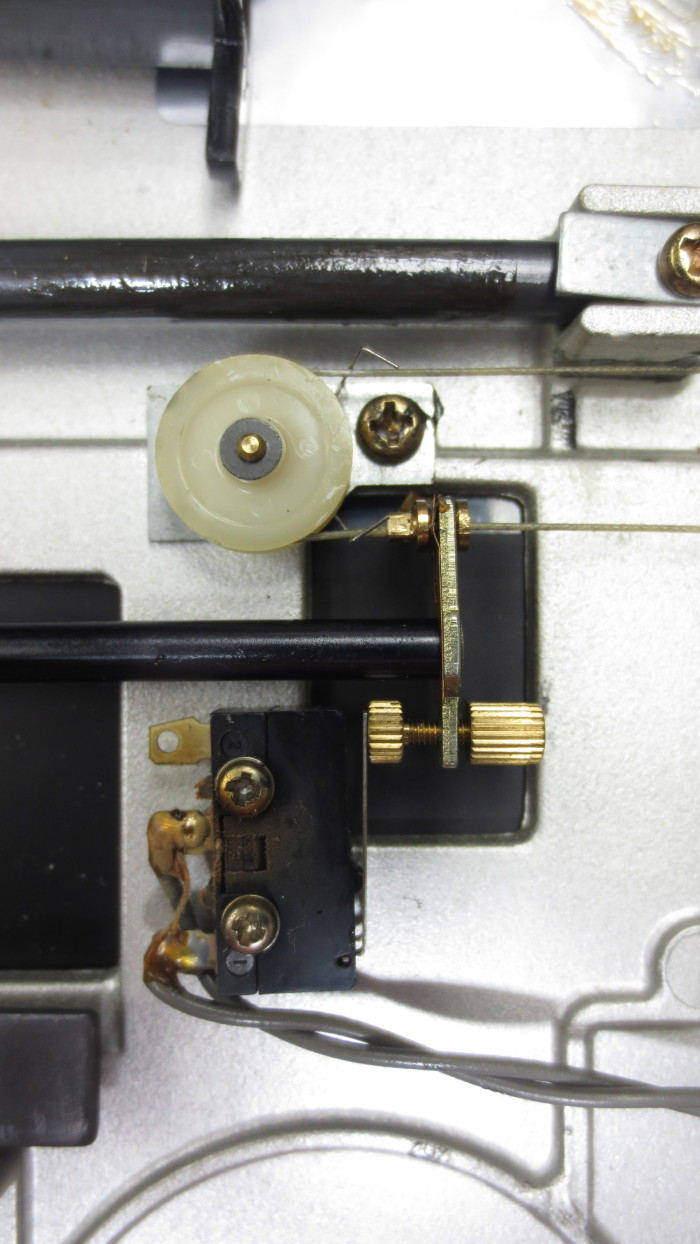
Technics SL 10 Turntable – A detail of the stop-switch (there are two of these); these allow the technician to adjust the exact moment when the arm descends and reruns, at the beginning and end of an LP.
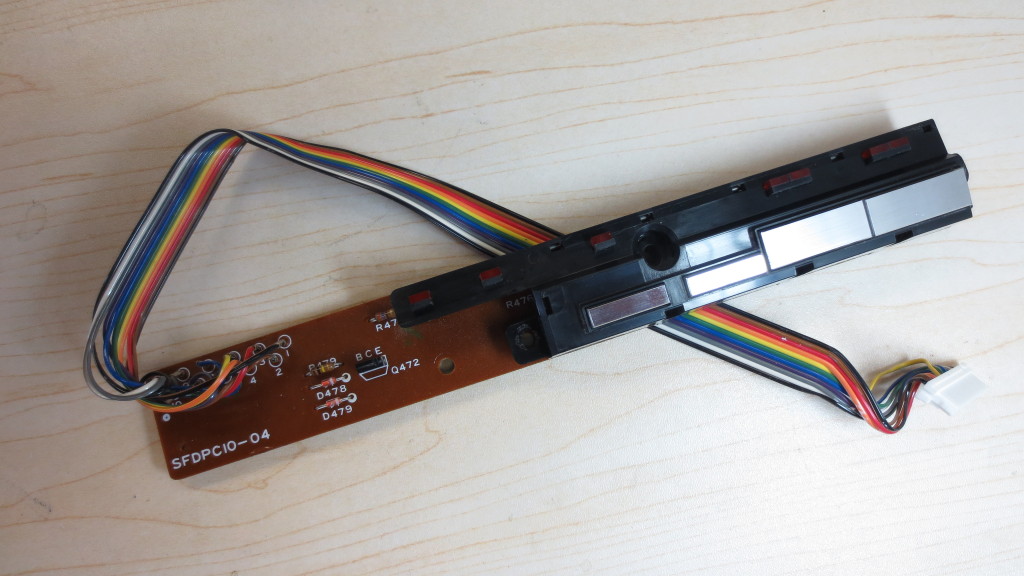
Technics SL 10 Turntable – As an afterthought, since the donor SL-10 was in pieces, why not get it to give up its topside switch plate?. The original had been corroded (maybe too many sweaty fingers…) and the donor switch plate was in pristine shape. After the relative complexity of replacing the thread-drive, this was a piece of cake. 🙂
To reflect on the SL-10 is a sobering process. In some ways it’s a guide to the last throes of the 20th century. it’s actually very hard to see how the machine could have been improved: the Matsushita Corporation was a mighty force with an enormous budget, and Japan showed no signs of the looming stagflation that was to come. The vinyl record reigned supreme as the listener’s choice, but something was happening in Europe…the letters CD were being uttered, and this was the beginning of the end for the LP.
Strangely enough, if one were to design a record player that offered most of the conveniences of the Compact Disc, even down to the size of the machine, then the Technics SL-10 would have been a logical result. It foreshadowed in some ways the insatiable desire for convenience that we have, and that produced the digital revolution.
And here we are now. The CD is ailing, possibly on its deathbed; downloads have trumped the little disc, and we are the iPod generation.
Looking at the Technics SL-10 is akin to a looking at a microcosmic snapshot. It will never return, and that makes me wistful. The minds and mindsets that produced it are gone and all we can do is admire from afar the wonders of mechanical and electronic progress that produced such a player.
One thing’s for sure: I’m keeping mine!
I have a Technics SL-10 tangential turntable which has had little use, and now I have some 4/6 thousand cds, I doubt it ever will again. I should be downsizing my audio equipment, which has been my life in recent years of old age. In the immortal words: “What’s it worth?” and “Where do I sell it?” Your advice would be appreciated
Hi, I’m in the market for a SL10, but I live in Durban, South Africa. Our exchange rate is 11.16 Rands to your 1 dollar.
Would you be prepared to ship it to me if we can agree on a price ? Thanks for your time. Andrew
As always, condition, mechanical and cosmetic, will be the determinants here. If you were to sell the SL-10 on the open market, and it was in mint condition, I would expect it to sell for $450, perhaps a little more with original box and paperwork. For an average functioning unit with the usual signs of age (minor scuffs etc) maybe $350 or so. The main things to consider will be the state of the cartridge, and whether all functions work just as they should. With these tables there is a drive belt that will inevitably fail – a relatively simple repair (although somewhat time-consuming), and this belt will effectively ‘crash’ the unit if old or frayed. An enterprise like The Turntable Shop will always be interested in buying good examples of this turntable, and of course there is always Ebay! Best regards, Nick
Hi Peter, the last example I saw of this turntable came from Canada. I have friends living in Vaughan Ontario who may be willing to keep it for me should you consent to sell it. Like the above message says, the value depends on how much use the cartridge has seen. It is a moving-coil design no longer made, but some specialist shops do undertake to re-tip them, for a wad of money. Please get in touch. A photograph of the SL10 would help. Mail to [email protected]
The Technics SL-10 in pristine condition can fetch from $350-$600. I think anything more than $600, the owner has sentimental feelings towards the turntable. I would say a good used turntable with a few nicks and scratches should sell for $325-$450. Average condition, $200-$325. A parts turntable is around $100-$200. These are just my “guesses”. I have one SL-10 that I am getting ready to restore. It’s in pretty good condition, but needs some attention, like replace the feet, new cartridge, tune up. They are good turntables! I would keep it because vinyl is coming back!
Looking for a replacement cord with ground and needle,please advise..
HI Glenn,
The originals are now getting on a bit…out of four that have come my way (from tables bought for parts) two af these cable and pin sets have been faulty. If my unit at home ever decides to fail I will end up, no doubt, devising a home-brew solution. Otherwise I don’t know of any readily available source of parts except Ebay. The dedicated design is something of a minor annoyance!
Best regards,
Nick
Hi Nick – I have a SL-10 and when i bought it i had to change the cartridge and the only one I got at that time was a Shure 1200 HRP . It plays good sometimes but other times it starts repeating the same note.
Can you give me any pointers on what to check out? is it the weight of the tonearm or something else? Thanks in advance.
Badri
Hi Badri,
My first line of inquiry would be the tracking weight. Adjusting this is a simple matter.
There should be a small screw at the base of the arm and recessed in the plastic shroud. Observing the directional arrow for adjusting tracking force turn the screw with a small screwdriver to increase the playing weight. This should resolve the issue you are experiencing.
If this should fail (and your record and stylus are clean!) observe the arm for the top whilst the record is playing. Is it remaining parallel?
Best regards,
Nick
Hi Nick – Thanks a lot, your advice worked. I increased the tracking weight a little and its playing well now.
Best
Badri
hi, i have an sl-10 from new.. but would like to get it refreshed…. new caps, belts etc… anyone you know of that can service?? thank you
Thanks for the great write up; I have inherited my fathers SL-10, which has fallen a few times. One of the push button clips was missing, so I picked up a plastic mold making kit, and using the remaining clip, produced a new one!
Hi Nick, I have a beloved Technics SL10 purchased new Hong Kong in 1977.
In the past 5 years it has developed a problem with the tangential tracking in that it will play OK for the first 2 or 3 tracks but as it progressively moves across the vinyl, the arm increasingly mis-aligns until it is at an angle that causes it to stick. Are you familiar with this fault and do you have any advice? I read your article on the thread drive but am not sure if this is the same fault.
I would love to bring the turntable to Vancouver but am a retiree in Sydney Australia and even my love for the SL10 will not support the cost of the trip!
Hi Nick, I really enjoyed your 2 part article here of the classic Technics SL-10. Great pics too! I have worked on a few of these for friends and was truly amazed at how well these were built. I noticed you didn’t post any pics of what lurks below the platter. This area must be seen to truly appreciate the design. They even mounted the larger caps sideways in order to not only fit under the platter but to keep the overall height down to 3.5 inches…very clever! I have a couple of good pics of this area I can send you if you want.
Once again, Fantastic writeup!
Thanks, Tim